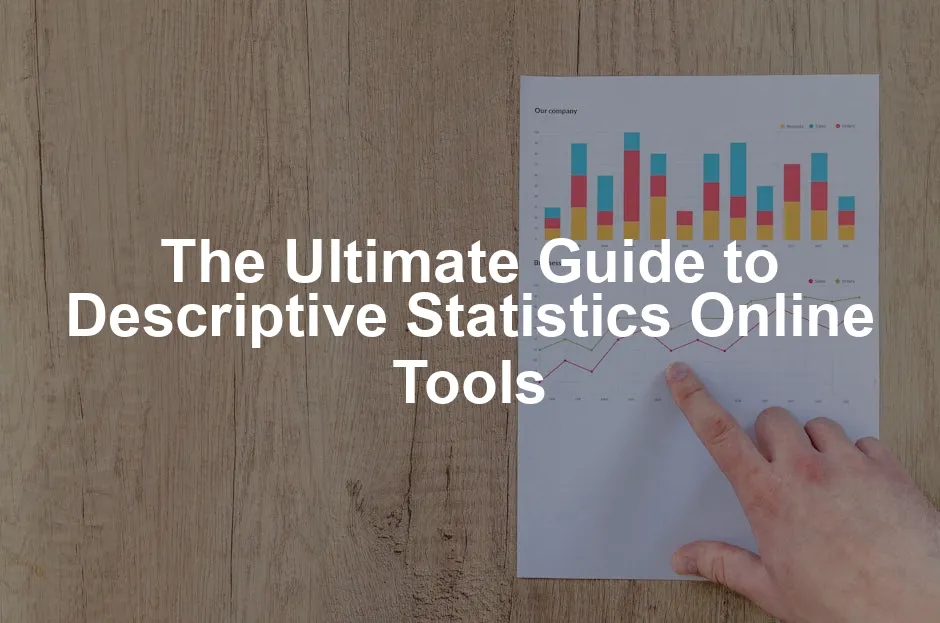Introduction
Descriptive statistics are the unsung heroes of data analysis. They help us summarize and understand complex data sets in a digestible format. Imagine trying to explain your weekend escapades to a friend using only numbers. Sounds tricky? That’s where descriptive statistics come in handy! They provide clarity by offering key insights through simple measures like mean, median, and mode.
Online tools have revolutionized the way we handle descriptive statistics. No more fussing over complicated software installations! With just a few clicks, you can access powerful calculators and visualizers that will do the heavy lifting for you. Need to calculate the average score of your favorite video game? Or perhaps you want to see how your test scores stack up? Online tools can help with that!
The purpose of this article is to guide you through the maze of online descriptive statistics tools. We’ll explore their features, usability, and tips to make the most out of them. Whether you’re a student, researcher, or just a curious data enthusiast, there’s a tool out there for you that can make number crunching fun and effortless. And speaking of fun, have you checked out Descriptive Statistics for Dummies? It’s a great read that breaks things down in a way that even your pet goldfish could understand!

Understanding Descriptive Statistics
What are Descriptive Statistics?
Descriptive statistics are like the highlights reel of your dataset. They summarize the essential features, allowing you to grasp the overall trends without getting lost in the minutiae. Picture it as the difference between reading a novel and its synopsis; the synopsis gives you the gist without all the details!
Common measures used in descriptive statistics include:
- Mean: The average value, calculated by summing all data points and dividing by the count. Learn more about what does mean identically distributed in statistics.
- Median: The middle value when data is ordered from smallest to largest. Check insights on the median salary in Poland for 2024.
- Mode: The most frequently occurring value in the dataset.
- Variance: A measure of how far each number in the set is from the mean.
- Standard Deviation: The square root of variance, indicating how spread out the numbers are.
- Range: The difference between the maximum and minimum values.
- Quartiles: Values that divide the data into four equal parts.
These measures help paint a clearer picture of your data, making it easier to interpret and analyze. If you’re looking to dive deeper into the world of statistics, consider grabbing a copy of Statistics for Business and Economics. It’s perfect for those who want to see how statistics apply in the real world!

Importance of Descriptive Statistics
Descriptive statistics play a crucial role across various fields. In business, they inform decisions by summarizing sales data and customer feedback. In healthcare, they help analyze patient outcomes and treatment effectiveness. In academia, researchers use them to present findings succinctly. Even in social sciences, they provide insights into trends and behaviors.
For example, a business analyzing customer satisfaction surveys can calculate the average score and identify the most common feedback. This enables them to make data-driven decisions about product improvements. Similarly, healthcare providers can summarize patient data to track treatment outcomes effectively. And if you ever need a refresher on these concepts, the book Naked Statistics: Stripping the Dread from the Data is a fantastic resource that makes learning about stats enjoyable!
Descriptive statistics are invaluable in transforming raw data into actionable insights, making them essential tools in any data analyst’s toolkit. By harnessing the power of descriptive statistics, you can unlock the potential within your data and make informed decisions that lead to better outcomes.

Overview of Online Descriptive Statistics Tools
Types of Online Tools
Online descriptive statistics tools come in various forms tailored to different needs. These include calculators, visualizers, and comprehensive analysis platforms.
Calculators are straightforward and focus on computing fundamental statistics. Tools like CalculatorSoup allow you to quickly find means, medians, and modes. Just input your data, hit ‘calculate,’ and voilà—statistical insights at your fingertips! To take your calculations to the next level, consider investing in a Graphing Calculator (Texas Instruments TI-84 Plus). It’s a classic among students!
Visualizers take things up a notch by providing graphical representations. Platforms like DATAtab enable users to create histograms and box plots. These visual aids help in comprehending distributions and spotting trends.
Comprehensive analysis platforms offer a mix of both calculators and visualizers. They provide in-depth statistical functions alongside detailed data visualizations. This all-in-one approach simplifies the analysis process for users who want more than just basic statistics. If you’re looking for a deep dive into data science, check out Data Science for Business: What You Need to Know about Data Mining and Data-Analytic Thinking. It’s a game changer!
The beauty of online tools lies in their ease of use. Forget about tedious installations—these tools are browser-based. You can access them anywhere, anytime. Whether you’re on your lunch break or lounging at home, just log in and start crunching numbers!

Key Features to Look For
When selecting an online descriptive statistics tool, consider the following key features:
- User-Friendly Interfaces: The best tools are intuitive. Look for platforms with clear instructions and easy navigation. A tool should feel like a friendly companion, not a puzzle!
- Range of Statistical Functions: Ensure that the tool covers various statistics. It should calculate means, medians, modes, standard deviations, and more. A versatile tool handles all your analytical needs in one place.
- Data Privacy and Security Measures: Your data is precious! Opt for tools that prioritize data privacy. They should process data locally and not store it externally, ensuring your information remains confidential.
- Visualization Capabilities: A good tool should not only crunch numbers but also present them visually. Look for options to generate histograms, box plots, and charts. This feature makes it easier to interpret results and share insights with others.
In the sea of online descriptive statistics tools, these features will help you find one that fits your needs perfectly. With the right tool in hand, data analysis can become a breezy and enlightening experience!

DATAtab
DATAtab is a powerful online tool for descriptive statistics. It allows users to analyze data effortlessly, catering to both beginners and seasoned statisticians. This tool generates a variety of descriptive statistics, including mean, median, standard deviation, and more. Users can simply copy and paste their data into the platform, and within moments, they get a comprehensive statistical summary.
One of DATAtab’s unique features is its multilingual support. The platform is available in several languages, including German, French, and Spanish. This makes it accessible to a broader audience, allowing users from different regions to utilize its capabilities without language barriers.
Additionally, DATAtab excels in data visualization. Users can create histograms, frequency tables, and bar charts directly from their data. This visual representation helps in understanding data distributions and trends at a glance. The intuitive design ensures that even those new to statistics can easily navigate the platform and generate insightful visualizations. And if you’re curious about some basic principles, grab a copy of Introduction to the Practice of Statistics. It’s a fantastic starting point!

User feedback highlights DATAtab’s user-friendly interface and versatility. Many users appreciate the straightforward data input process and the immediate generation of results. Reviews often mention how the visual tools enhance their understanding of data, making complex analytics more manageable. Overall, DATAtab stands out as a reliable choice for anyone seeking to perform descriptive statistics online.
Stats Kingdom
Stats Kingdom offers a comprehensive approach to descriptive statistics, combining scientific rigor with user-friendly features. This platform provides a customizable environment to analyze both numerical and categorical data. Users can select various statistics to compute, including mean, median, and a range of dispersion measures. The tool’s flexibility allows for deep analysis, catering to diverse datasets.
Among its standout features is the ability to clean and prepare data before analysis. This ensures that users can focus on insights rather than getting bogged down in data management. The platform also supports advanced statistics, making it suitable for professionals in research and academia. Users can conduct hypothesis testing and regression analysis seamlessly.
A practical example of Stats Kingdom in action can be seen in healthcare research. Researchers analyzing patient data can use the platform to summarize outcomes and trends effectively. For instance, a team studying treatment efficacy could input patient recovery rates and generate comprehensive statistics. This allows them to make informed decisions based on robust data analysis. And if you’re interested in a solid foundational text, check out Statistics Made Easy—it’s a breeze to read!
Overall, Stats Kingdom is a valuable tool that combines thorough analysis with a user-driven approach, making it a favorite among researchers and data analysts alike.

WeDoDataScience
WeDoDataScience makes data analysis a breeze with its intuitive interface. Users can easily upload datasets in various formats, including CSV files, making the process smooth and efficient. The platform is designed to simplify the data analysis journey, ensuring that even novices can navigate it with ease.
Key features of WeDoDataScience include the ability to create histograms and frequency tables. These visual tools are crucial for understanding the distribution of data at a glance. For instance, a user analyzing survey results can quickly generate a histogram to visualize responses, making it easier to spot trends and patterns. If you’re looking to enhance your data visualization skills, consider Data Visualization: A Practical Introduction. It’s a fantastic resource!
Consider a case where a small business owner wants to analyze customer feedback. By uploading their data to WeDoDataScience, they can instantly create visual representations of customer satisfaction scores. This enables them to identify areas for improvement swiftly. The platform’s focus on usability ensures that users can derive insights without feeling overwhelmed by technical jargon or complex procedures.

NCSS
NCSS is a heavyweight champion in the world of descriptive statistics. It doesn’t just crunch numbers; it offers advanced features that would make any data analyst’s heart skip a beat! From basic summaries like mean and median to sophisticated metrics such as skewness and kurtosis, NCSS covers it all. Users can generate customizable summary tables, making it easy to present findings in a professional format.
One of the standout features of NCSS is its robust graphical capabilities. Users can create stunning visualizations to help interpret data trends. Whether you’re looking to generate box plots, histograms, or scatter plots, NCSS delivers with style. This functionality is especially vital in academic and research settings where clarity and precision are non-negotiable. If you’re interested in mastering the basics of statistics, pick up a copy of The Elements of Statistical Learning: Data Mining, Inference, and Prediction. It’s a must-read!
Speaking of academic environments, NCSS is highly suitable for students and researchers alike. Its comprehensive analytics cater to various fields, including medical research and social sciences. Many universities endorse NCSS for its reliability and depth, making it a go-to tool for students tackling complex datasets. Moreover, its user-friendly interface ensures that even those new to statistics can navigate it with ease.

User testimonials rave about NCSS’s effectiveness. One researcher noted, “NCSS transformed my data analysis process. It’s a powerful tool that’s as intuitive as it is versatile.” Another user claimed, “I’ve tried several software options, but NCSS is the best for advanced statistical analysis. It’s user-friendly and backed by great support.” These success stories illustrate how NCSS not only meets user needs but also exceeds expectations, making it an invaluable resource in any data analyst’s toolkit.
GraphPad QuickCalcs
GraphPad QuickCalcs is your trusty sidekick for scientific analysis. Designed with researchers in mind, this tool provides specific functionalities tailored for the scientific community. Need to calculate means, standard deviations, or confidence intervals? QuickCalcs has you covered! Just input your data, choose the appropriate calculator, and watch the magic happen.
What sets QuickCalcs apart is its user-friendly interface. The platform is intuitive, allowing users to focus on their analysis rather than wrestling with complicated software. You can easily enter your data, select the desired statistical tests, and receive results in seconds. This efficiency is a game-changer for busy researchers who need rapid insights without unnecessary hassle. And if you need a solid reference book, R Programming for Data Science is a fantastic resource to enhance your coding skills!

For example, consider a clinical trial where researchers need to analyze patient recovery times. Using QuickCalcs, they can quickly enter the recovery data, select the mean and standard deviation calculations, and instantly visualize their findings. This rapid turnaround enables researchers to make data-driven decisions faster, ultimately benefiting study outcomes.
Moreover, QuickCalcs is designed to facilitate reproducibility in research. By providing clear output and the ability to export results, it ensures that scientists can share their methodologies and findings with ease. In a field where transparency is crucial, QuickCalcs shines as a reliable tool that enhances research integrity.

How to Choose the Right Tool
Choosing the right descriptive statistics tool can feel like finding a needle in a haystack. With so many options out there, it’s crucial to consider several factors to find the best fit for your needs. First, think about your purpose. Are you a student needing basic calculations for a class project, or are you a researcher requiring advanced analytics? Understanding your specific needs is the first step.
Next, evaluate ease of use. A tool that’s complicated will only add frustration to your analysis. Look for platforms with intuitive interfaces and straightforward navigation. User-friendly designs let you dive right into your data without a steep learning curve.
Required features come next on the checklist. Do you need a tool for basic calculations, or do you require advanced statistical tests? For instance, researchers may need options for hypothesis testing, while students might only need descriptive statistics. Ensure the tool you choose has the functions relevant to your work. If you’re also interested in business applications, I’d recommend Microsoft Excel 2019 Data Analysis and Business Modeling. It’s an essential tool for any analyst!

Data privacy is another essential factor. Always opt for tools that prioritize user data security. Make sure your sensitive information remains confidential, especially if you’re handling research data that could be at risk.
Finally, consider the user type scenarios. Students typically need straightforward tools for homework and projects, while researchers might require comprehensive platforms for in-depth analysis. Business analysts, on the other hand, might look for tools that can handle large datasets efficiently. Tailoring your choice to your specific context will make a significant difference in your analytical experience.
With these factors in mind, you can navigate the ocean of descriptive statistics tools and find the perfect match for your analytical needs!

Conclusion
Descriptive statistics serve as the backbone of effective data analysis. They help us summarize complex datasets into digestible nuggets. This process is like turning a mountain of numbers into a crystal-clear insight. Online tools for descriptive statistics have made this task easier and more accessible than ever.
These tools are not just convenient; they empower users to make data-driven decisions. Whether you’re a student working on a project or a professional analyzing business metrics, these online resources can save time and enhance understanding. Imagine using a calculator that not only computes the mean but also visualizes your data with stunning graphics. It’s like having a mini data scientist at your fingertips!
As we explored various tools, it became clear that there’s something for everyone. From user-friendly calculators for beginners to advanced platforms for seasoned analysts, the options are plentiful. Each tool offers unique features and capabilities tailored to different needs. If you’re interested in a comprehensive overview, you might want to check out The Data Science Handbook. It’s a fantastic resource for anyone looking to dive deeper into data science!

So, don’t just sit there—start exploring! Dive into the world of descriptive statistics and find the tool that suits you best. With the right tool, analyzing your data can be an exciting adventure rather than a daunting task. Remember, the insights you uncover today can fuel your decisions tomorrow.
Ready to get started? Find your perfect descriptive statistics tool and unleash the power of your data today!
FAQs
What is the difference between descriptive and inferential statistics?
Descriptive statistics summarize and describe the main features of a dataset. They provide insights through measures like mean, median, and standard deviation. Inferential statistics, on the other hand, use a sample to make inferences or predictions about a larger population. In essence, descriptive statistics lay the groundwork, while inferential statistics build upon it to draw broader conclusions.
Can I trust online calculators for data analysis?
Absolutely! Most reputable online calculators have undergone rigorous testing for accuracy. They often provide results consistent with traditional statistical software. However, it’s wise to double-check your results, especially for critical analyses. Always ensure that you’re using a reliable tool and understand the calculations being performed.
Are online tools suitable for professional use?
Yes, online tools can be highly effective in professional settings. Many businesses utilize these calculators for quick analyses and visualizations. They are particularly useful for small to medium-sized businesses lacking access to expensive software. However, for more complex analyses, specialized software might still be necessary.
Do I need any special skills to use these tools?
Not at all! Most online descriptive statistics tools are designed with user-friendliness in mind. They often feature intuitive interfaces that guide you through the process. Whether you’re a beginner or an expert, these tools are accessible and can make data analysis straightforward and enjoyable.
What types of data can be analyzed with these tools?
You can analyze a wide variety of data types, including numerical and categorical data. Most tools accept data entered as lists, tables, or files (like CSV). Whether you’re dealing with test scores, sales figures, or survey results, there’s a tool that can handle it. Just ensure your data is in a compatible format and you’re good to go!
Please let us know what you think about our content by leaving a comment down below!
Thank you for reading till here 🙂
All images from Pexels




